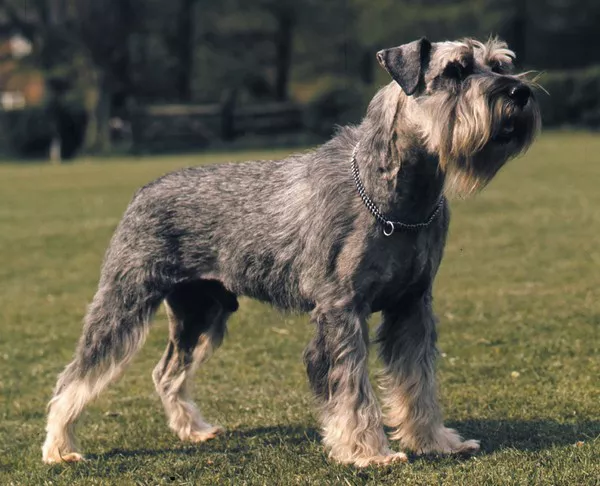Schnauzers are a beloved group of dog breeds known for their distinctive beards and eyebrows, giving them a charming and dignified appearance. While many people are familiar with the Standard Schnauzer, there are actually three distinct types of Schnauzer breeds, each with its own unique characteristics and qualities. In this article, we will explore the three types of Schnauzer breeds: the Standard Schnauzer, the Miniature Schnauzer, and the Giant Schnauzer, shedding light on their differences and what makes each breed special.
1. Standard Schnauzer
Size: The Standard Schnauzer is the medium-sized member of the Schnauzer family, with an average weight of 30 to 45 pounds (14 to 20 kg) and a height of 17.5 to 19.5 inches (44 to 50 cm).
Characteristics:
Alert and Spirited: Standard Schnauzers are known for their alert and spirited personalities. They are often described as “in-between” in terms of energy levels compared to their smaller and larger counterparts.
Versatile: They are versatile dogs, excelling in various roles such as working dogs, family pets, and even as therapy dogs.
Distinguished Appearance: Standard Schnauzers have a sleek and elegant appearance with a dense, wiry coat that can be salt-and-pepper, black, or solid white.
2. Miniature Schnauzer
Size: Miniature Schnauzers are the smallest of the Schnauzer breeds, typically weighing between 11 to 20 pounds (5 to 9 kg) and standing about 12 to 14 inches (30 to 36 cm) tall.
Characteristics:
Energetic and Playful: Miniature Schnauzers are known for their energetic and playful nature. They are often considered lively and spirited companions.
Great Family Dogs: They make excellent family pets, known for their affectionate and loving demeanor.
Distinctive Coat: Miniature Schnauzers have a wiry double coat that can come in various colors, including salt-and-pepper, black and silver, and solid black.
3. Giant Schnauzer
Size: The Giant Schnauzer is the largest of the Schnauzer breeds, with an average weight of 65 to 95 pounds (29 to 43 kg) and a height of 23.5 to 27.5 inches (60 to 70 cm).
Characteristics:
Protective and Loyal: Giant Schnauzers are known for their protective instincts and loyalty to their families. They make excellent guard dogs.
High Energy: They are high-energy dogs that require regular exercise and mental stimulation to stay content.
Distinguished Appearance: Giant Schnauzers have a bold and imposing appearance with a dense, wiry coat that is typically solid black or salt-and-pepper.
Conclusion
The three types of Schnauzer breeds—Standard, Miniature, and Giant—each have their own unique qualities and characteristics, making them suitable for different lifestyles and preferences. Whether you’re looking for a lively and playful companion, a versatile working dog, or a protective and loyal guardian, there’s a Schnauzer breed to suit your needs.
FAQs about the three types of Schnauzer breeds:
Q1: What are the main differences between the three Schnauzer breeds?
A1: The main differences lie in their size, energy levels, and temperament. Standard Schnauzers are medium-sized and versatile, Miniature Schnauzers are small, lively, and great for families, and Giant Schnauzers are large, protective, and loyal.
Q2: Are Schnauzers good family dogs?
A2: Yes, Schnauzers, particularly the Miniature and Standard breeds, are known for being great family dogs. They are affectionate, loyal, and often get along well with children and other pets.
Q3: Are Schnauzers hypoallergenic?
A3: Schnauzers have a wiry, non-shedding coat that can be considered hypoallergenic. However, no dog breed is entirely hypoallergenic, as allergies can vary among individuals.
Q4: Do Schnauzers require a lot of grooming?
A4: Schnauzers, especially the Miniature and Standard varieties, have a distinctive coat that requires regular grooming. They need to be brushed, trimmed, and professionally groomed to maintain their coat’s texture and appearance.
Q5: Are Schnauzers easy to train?
A5: Schnauzers are intelligent and can be trained effectively with consistent and positive reinforcement methods. However, they can also be independent thinkers, so patience and firmness are essential in training.
Q6: Do Giant Schnauzers make good guard dogs?
A6: Yes, Giant Schnauzers are known for their protective instincts and make excellent guard dogs. They are loyal to their families and can be wary of strangers.
Q7: Are Schnauzer breeds suitable for apartment living?
A7: Miniature Schnauzers can adapt well to apartment living due to their smaller size and moderate exercise needs. Standard and Giant Schnauzers are better suited to homes with more space and access to outdoor areas.
Q8: How long do Schnauzer breeds typically live?
A8: The lifespan of Schnauzer breeds varies, but on average, they can live between 12 to 15 years with proper care.
Q9: Are Schnauzer breeds prone to specific health issues?
A9: While generally healthy, Schnauzer breeds can be prone to certain health issues such as hip dysplasia, eye problems, and skin conditions. Regular veterinary check-ups are essential for early detection and prevention.
Q10: Are Schnauzer breeds known for being good with children?
A10: Schnauzer breeds are often good with children when properly socialized and raised with them. They can be playful and affectionate companions for kids.
Q11: Do Schnauzer breeds get along with other dogs and pets?
A11: Schnauzers can get along with other dogs and pets, especially if introduced and socialized properly from a young age. However, some may have strong prey drives, so caution is needed around smaller animals.


